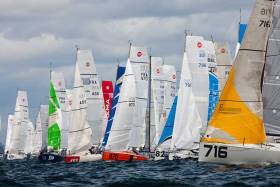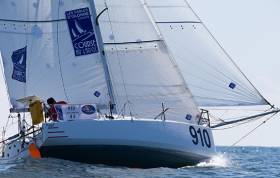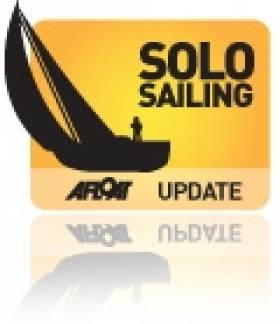Displaying items by tag: Tom Dolan
Mini Transat: Fully Booked, One Irish Adventure Sailor in 84–Boat Fleet
Solo Sailor Tom Dolan from County Meath has booked his place in October's Mini–Transat Race from La Rochelle to Martinique.
The sole Irish entry was in Dublin last night to talk about his exploits at Poolbeg Yacht and Boat Club. This will be Dolan's second Mini–adventure having successfully competed in 2015.
For this 2017 edition of the race, organised by Collectif Rochelais pour la Mini Transat, the race will host a full contingent as the number of applicants signed up for the adventure already exceeds the 84 places available. Download the full entry list below.
- The Mini Transat 2017 will set sail from La Rochelle
- Las Palmas de Gran Canaria and Le Marin (Martinique) the stopover and finish venues
- 84 competitors expected on the start line on 1 October 2017
Forty years on from its first edition, the Mini Transat remains on the crest of the wave. A maiden voyage for some, a stepping stone to further sporting challenges for others, the Mini Transat holds a very special place in the world of offshore racing. In an era of new technologies and intensive communication, it is still the only event where each racer is pitted solely against themselves during a transatlantic crossing. No contact with land, no other link to the outside world than a single VHF radio, at times the Mini Transat is a voyage into solitude.
Boats: minimum length, maximum speed
With an overall length of 6.50m and a sail area pushed to the extreme at times, the Minis are incredibly seaworthy boats. Subjected to rather draconian righting tests and equipped with reserve buoyancy making them unsinkable, the boats are capable of posting amazing performances in downwind conditions… most often to the detriment of comfort, which is rudimentary to say the least. In the Class Mini, racers can choose between prototypes and production boats from yards. The prototypes are genuine laboratories, which frequently foreshadow the major architectural trends, whilst the production boats tend to be more somewhat tempered by design.
Racers: from the amateur to the future greats of offshore racing
There are countless sailors of renown who have made their debut in the Mini Transat. From Jean-Luc Van Den Heede to Loïck Peyron and Thomas Coville, Isabelle Autissier and Sam Davies, a number of offshore racing stars have done the rounds on a Mini. However, the Mini Transat is also a lifelong dream for a number of amateur racers who, in a bid to compete in this extraordinary adventure, sacrifice work and family to devote themselves to their consuming passion. Nobody comes back from the Mini Transat completely unchanged. This year, there will be 84 solo sailors, 10 of whom are women! The Mini Transat is also the most international of offshore races with no fewer than 15 nationalities scheduled to take the start.
The course: from La Rochelle to the West Indies via the South face
Two legs are offered to make Martinique from Europe’s Atlantic coasts. The leg from La Rochelle to Las Palmas de Gran Canaria is a perfect introduction to proceedings before taking the big transatlantic leap. The Bay of Biscay can be tricky to negotiate in autumn while the dreaded rounding of Cape Finisterre on the north-west tip of Spain marks a kind of prequel to the descent along the coast of Portugal. Statistically, this section involves downwind conditions, often coloured by strong winds and heavy seas. Making landfall in the Canaries requires finesse and highly developed strategic know-how.
The second leg will set sail on 1 November. Most often carried along by the trade wind, the solo sailors set off on what tends to be a little over two weeks at sea on average. At this point, there’s no way out: en route to the West Indies, there are no ports of call. The sailors have to rely entirely upon themselves to make Martinique, where they’ll enjoy a well-deserved Ti Punch cocktail to celebrate their accomplishments since embarking on the Mini adventure.
After a promising first solo leg of “Les Sables-Les Azores-Les Sables”, Ireland's Thomas Dolan, or l’irlandais Volant”, or the Flying Irishman, as he has been christened by French media, currently stands in second place with 1 hour and 35 minutes of a gap between himself and France’s Tanguy Bouroullec, who dominated the first 1200 miles of racing.
After crossing Biscay in relatively light winds, the fleet of 22 mini 650’s had an intense three days of reaching in 20 to 25 knots of wind. This allowed them to hastily tuck into the 800-mile offshore leg from the north of Spain to the Azores Archipelago. Most of the routings at the start had tended to favor a southern route, skipping along the edges of a ridge of high pressure which stretched across the Bay of Biscay. However, things rarely being as they are announced in ocean racing and the Azores High began to move westerly with the competitors, opening up a corridor or Northerly wind along the rhumb line.
The mini class prides itself in being ‘low-tech’. Thus the only weather forecasting available to the skippers once they are at sea is a barometer, the clouds and a Shortwave radio transmission once per day. Dolan ended up taking a rather mediocre route, not too south and not too north and was in 6th place as the fleet arrived in the Islands. As the fleet compacted into the high pressure zone, it was almost like a second start. 24 hours of close contact tacking and the Meath man had managed to come out in second, having cut Bouroullec’s lead from 20 to 7 miles.
Having experienced problems with his generator, Dolan had to run a number of nights without use of the autopilot and even navigation lights. It was only when the sun rose and the solar panels kicked in that he could rest and recharge both his and the boat’s batteries. “At one stage I looked at the GPS and saw 750 miles to go and though it’s impossible I’ll have to turn around and pull into a Spanish port….” But he held out and even though there is less than 15 minutes between Dolan and the sixth place boat he remains hopeful of an overall podium finish.
The second leg leaves on Tuesday at 1700 Irish Time. There will be a complex ridge of high pressure too cross in search of a weak cold front which will sweep across the Bay of Biscay. Some of the routings even send the fleet as far north as the Fastnet Rock! So it is certain that the game is long from over.
Tom Dolan Makes Good start for Ireland in Mini Transat
Irish solo sailor Tom Dolan's dream of competing in this year's Mini–Transat came true yesterday when the County Meath man departed Douarnenez in France and embarked on his 4000–mile race.
It’s hard to imagine better conditions for the start of the Mini Transat îles de Guadeloupe. The President of the racecourse fired the starter’s pistol, and the competitors launched themselves into the westerly to north-westerly 8-10 knot wind. By the end of the first part of the race in the bay, the favourites were already pointing their bows towards the open ocean.
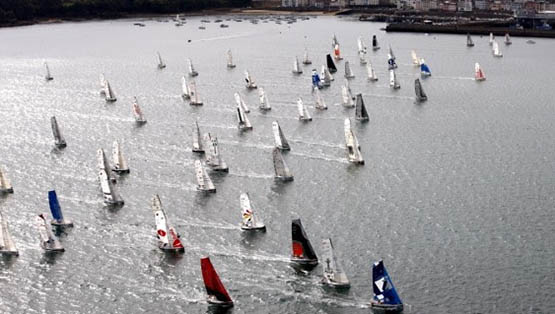
Yesterday's start in Douarnenez Bay
You can follow Tom's progress via the race tracker
There was enough wind to move forwards, but not too much. We couldn’t have hoped for more at the start of a transatlantic race, both for the competitors, and for the organisers. Douarnenez Bay had dressed up in its finery: blue skies, light clouds at the top of Menez Hom, dark seas…
The Mini Transat îles de Guadeloupe racers hardly had time to admire the landscape. Instead they had to watch their rivals, avoid collisions and consider their tactics for the best approach to the race in Douarnenez Bay.
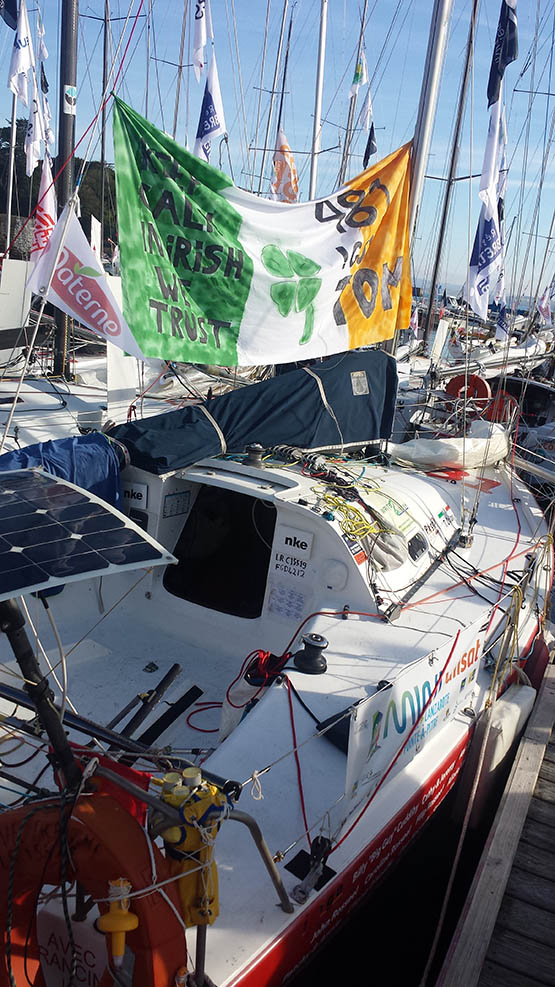
The County Meath yacht is prepared for the off in Douarnenez – Photo: Paul Keane
After a beautiful start on the starboard side, Hervé Aubry (Ixina – Voilerie HSD) was in the lead, followed closely by the youngest competitor, Quentin Vlamynck (Arkema) and Clément Bouyssou (Le Bon Agent ! Bougeons l’Immobilier). However, it was Davy Beaudart (Flexirub), followed by Frédéric Denis (Nautipark) who were leading the fleet at the first buoy. Next, was Julien Pulvé (Novintiss) who overtook Benoît Hantzperg (YCA – Dhumeaux – Secours Populaire).
Tacking re-shuffles the playing cards
At buoy number 2, Fred Denis had taken matters into his own hands, thanks to an ingenious double tack in the direction of the coast. Many of the following competitors took advantage of these tactics to improve their times and re-join the leaders of the fleet, including an inspired Fidel Turienzo (Satanas).Benoît Hantzperg also profited from this windfall to pinch first place from Julien Pulvé, whilst Tanguy Le Turquais manouevred his Terréal into third position.
This was followed by a stretch of quite closed spinnaker sailing in a straining wind that forced a real break amongst the favourites in training at the centre of the fleet, particularly caused by the comfortable conditions. For others, the problem was that they had hardly experienced this type of sailing on a razor’s edge. A first hierarchy had established itself by the time they reached the buoy at Tristan island, which marks the end of the coastal run. Ahead of them unfolded a long stretch towards the west until they crossed the Seine current. The objective was to get around a light patch sitting directly in their path, and look for a faster route by using the winds from the northwest.
Lucky for some…unlucky for others
For the majority of the fleet, the positioning in the coastal race was an epiphany, to know who to look out for in the following week. Tomorrow, when the first night is over, each one of them will have forgotten the little miserable moments they will have during these 5,000 miles of prelude to the main race. Even Axel Tréhin (Aleph Racing), who tried to make too tight a turn around the first buoy, and was entangled for a long time in its moorings, will have forgotten about how many positions he dropped because of his greedy attempt.
It’s another story for Nacho Postigo. He was violently slammed against the rocks of Tristran Island when he was being towed by an organiser’s boat, and saw his hopes for the Transat dashed as well. With his keel sail damaged and the bulb mashed up, the Spanish sailor could not go straight back to the race. However, he will be able to re-join the ranks in two stages, as the crash was not his responsibility. The international jury will need to decide under what criteria he can re-join the race. The members already know that there will be the work cut out waiting for him to do in Lanzarote.
Positions after the coastal race:
Prototypes (Eurovia Cegelec class):
1 Fred Denis – 800 – Nautipark
2 Davy Beaudart – 865 – Flexirub
3 Clément Bouyssou – 802 – Le Bon Agent ! Bougeons l’Immobilier
4 Luke Berry – 753 – Association Rêves
5 Jean-Baptiste Daramy – 814 – Chocolats Paries – Coriolis Composites
Séries (Ocean Bio-Actif Ranking)
1 Benoît Hantzperg – 871 – YCA – Dhumeaux – Secours Populaire
2 Tanguy Le Turquais – 835 – Terréal
3 Charly Fernbach – 869 – Le Fauffiffon Hénaff
4 Antonio Fontes – 745 – Vela Solidaria
5 Ian Lipinski – 866 –Entreprises Innovantes
#minitransat – On 19 September 2015, Ireland will be among 84 Mini–Transat 2015 competitors heading out to do battle with the Atlantic for the 20th edition of the Mini Transat. As was the case in 2013, the race will set sail from Douarnenez in north-west Brittany. County Meath sailor Tom Dolan launched a Mini Transat solo sailing campaign in December as Afloat previously reported.
Dolan's first qualifying race is the 150–miles double–handed Lorient Bretagne Sud Mini race on April 11.
For this second edition starting out from Douarnenez - the third if we go back to 1991 when the town first hosted the Mini Transat - the Douarnenez Courses team is building on past experience whilst ensuring continuity with a return to Douarnenez' first harbour, the basin of Port Rhu, a genuine showcase for the Mini fleet that proved so successful in 2013.
With some 78 racers already pre-registered, the Mini Transat is once again guaranteed to have a full line-up. Among the entries we find some of last edition's front runners in the proto ranking including Michele Zambelli, Ludovic Mechin and Romain Mouchel, who are back once more to try their luck. They'll be joined by some of the movers and shakers of the Mini Class, who have traded in their series boats for a prototype, such as Clement Bouyssou and Davy Beaudart with his Maximum, the sistership to the famous Magnum, which won the Mini Transat 2011 and secured second place in the Mini Transat 2013.
In the series fleet, all eyes will be on the battle between the Nacira designs, which dominated the competition in 2013 in the hands of Damien Cloarec, Jonas Gerckens and Patrick Girod. Also worth following are the Argos, led by Tanguy Le Turquais, and the two latest newcomers (provided they are granted the status of a series boat), the Pogo 3 and the Ofcet, skippered by Ian Lipinski and Julien Pulve respectively.
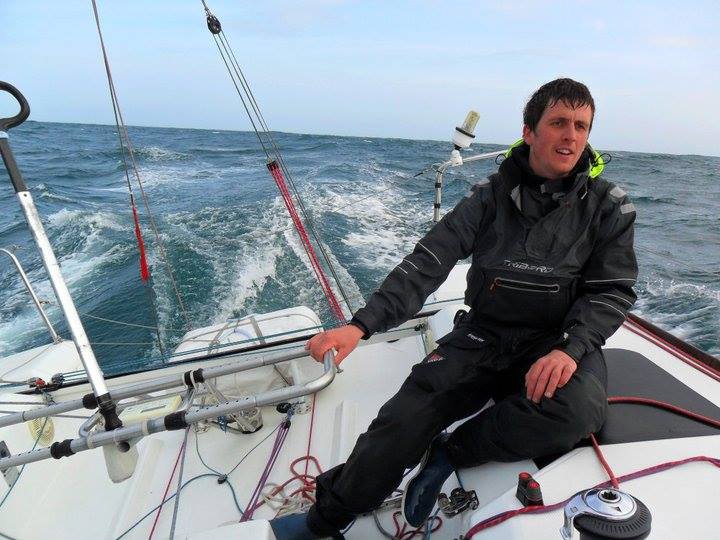
County Meath sailor Tom Dolan
More on www.minitransat.fr


























